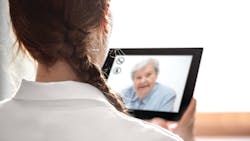A guide to teledentistry in the time of COVID-19
The COVID-19 pandemic swept across the globe with ease, hitting every continent in no time at all. As the cases rose, government officials began implementing tactics to slow the spread of the virus. Those tactics included social distancing, staying home unless absolutely necessary, and widespread lockdowns in the most hard-hit areas. When lockdowns were in effect, only essential services remained open to serve the public. One sector deemed nonessential and forced to close was dentistry, but as dental professionals know, oral health is just as important as any other form of health.1
Despite the new vaccines and hopes to lower overall virus case numbers, much of the dental industry is waiting in limbo for another potential shutdown. But there is a light at the end of this tunnel, and that is teledentistry.
Teledentistry can operate even in the event of a total shutdown, because it does not require chair time or face-to-face interactions. This could mean everything to patients who need oral care. In fact, there is so much that teledentistry can do for both patients and practitioners, that even if all dental offices are closed, care is still accessible for those in need.
Many of you may have the initial thought: how is this possible when the dental industry is so hands-on? This is true, for many situations, but there are also many areas of dental care and patient interaction that can be substituted with teledentistry.
Total shutdown does not mean putting oral health on hold
With the possible threat of a total shutdown looming due to rising cases in many areas, some dental offices will be relegated to urgent care only. We know that dental professionals are well-versed in best infection prevention practices. In fact, when the pandemic took hold, they were even more diligent with new disinfection methods, enhanced standard operating procedures, and screening protocols.
This attention to the needs of both the population at large and the patients we see daily has made dental offices one of the safest health-care facilities during the pandemic. If a shutdown were to occur, though, it is likely that dental offices would return to the nonessential list yet again. This is where teledentistry can come into its own.
The benefits of teledentistry during COVID-19
Teledentistry has made the lives of patients easier by reducing the time spent getting to and from the dentist and time spent in the chair. It has also saved them money on visits for issues that a virtual appointment could deal with just as efficiently. That is not the only benefit of using this technology, however.
Since the onset of COVID-19, personal protective equipment (PPE) conservation has been of the utmost importance.2 Health-care workers are on the frontlines of the battle against the spread of the virus, and they need all the protective wear they can get. That said, dental offices require just as much PPE as medical offices, because they are up close and personal with their patients. Dental practices may need to continue seeing some patients face-to-face for more serious treatments or procedures, but by using teledentistry, there is a significant reduction in overall chair time. Teledentistry also lowers costs, so more patients may decide to book a virtual appointment if it suits their budget, especially for those who have lost their jobs due to the viral outbreak.3 This makes dental care more accessible to everyone, allowing dental offices to take in more revenue from those who otherwise could not afford to make an appointment.
In the specific case of an aerosol-generating procedure (AGP), PPE is vital in limiting transmission. By offering teledentistry to patients who do not need to come into the office, the practice is protecting them from being exposed to those AGPs and can conserve PPE supplies that would have been needed for in-office appointments.
Other aspects of dental care possible through virtual appointments include:
- Reviewing insurance claims
- Treatment consultations
- Reviewing treatment plans
- Pre- and post-op instructions
- Hygiene checks
- Patient follow-ups to check on healing, postoperative pain, etc.
The practice can benefit just as much as the patient
For dental professionals worried about transmitting the virus themselves, teledentistry can solve that issue without having to shut down the office or miss appointments. For example, if a treatment coordinator needs to self-quarantine, but still has work to do on insurance claims and reviews with patients, the team member can complete that work from the comfort of home.
Also, if patients with COVID-19 have oral health issues that require follow-up appointments, they do not need to risk missing a reevaluation of their progress following their dental procedure just because they are COVID-19–positive. With the use of a video call and a HIPAA-compliant program, it is still possible to meet these patients’ clinical needs and determine if an in-office visit is vital or could wait until they are no longer infectious.
If a dental professional has to stay home to quarantine after a spouse or family member becomes ill, dental appointments can still continue with the use of teledentistry. Hygienists can gather all of the necessary information required for dentists to review from their home offices. They can then relay results to patients during virtual appointments. Dentists can even be in the room virtually in real-time with the patient and hygienist if any exams require it.
Protecting patients’ health
Government officials may have deemed dentistry a nonessential service during previous COVID-19 shutdowns, but this was an oversight regarding the importance of dental health and its effect on overall health. However, should further waves of the virus occur, a total shutdown is not necessary if dental practices have the correct teledentistry tools and protocols in place.
Reducing chair time and maintaining social distancing can be easier said than done in a profession that requires close personal contact. But with the advancements in technology, this should not create an immovable barrier between dental care and the pandemic. Teledentistry can be the saving grace for oral health everywhere. Since it’s going to be awhile until things return to “normal,” teledentistry can put safe oral care at the forefront of patients’ minds so that any issues can be prevented or assessed with ease. The tools are there; they just need to be used.
References
- Brian Z, Weintraub JA. Oral health and COVID-19: increasing the need for prevention and access [published correction appears in Prev Chronic Dis. 2020;17:E93]. Prev Chronic Dis. 2020;17:E82. doi:10.5888/pcd17.200266
- Ghai S. Teledentistry during COVID-19 pandemic. Diabetes Metab Syndr. 2020;14(5):933-935. doi:10.1016/j.dsx.2020.06.029
- Kumar N, John N, Devi N, Vivek S, Ravishankar P, Somaraj V. Teledentistry: an overview. J Clin Res Dent. 2019;2(2):1-2.
About the Author
Michelle Strange, MSDH, RDH
Michelle Strange, MSDH, RDH, has more than two decades of dental expertise, beginning as a dental assistant and completing a bachelor’s degree in health science from the Medical University of South Carolina and a master’s in dental hygiene education from the University of Bridgeport. She continues to invest in ongoing education, gaining certifications such as her Certificate in Dental Infection Prevention and Control. Her community and global endeavors demonstrate her passion for dentistry, from volunteer work to worldwide missions. She is the owner of Level Up Infection Prevention, MichelleStrangeRDH, a practicing dental hygienist, and was the cofounder and the fire and energy that made A Tale of Two Hygienists podcast.
Read Strange's DE Editorial Advisory Board profile here.
Updated October 10, 2022


